Puppy Linux on:
[Wikipedia]
[Google]
[Amazon]
Puppy Linux is a family of
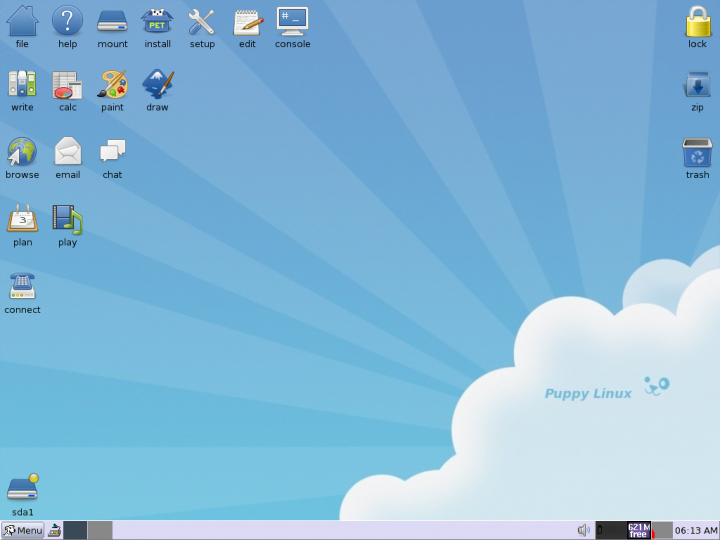



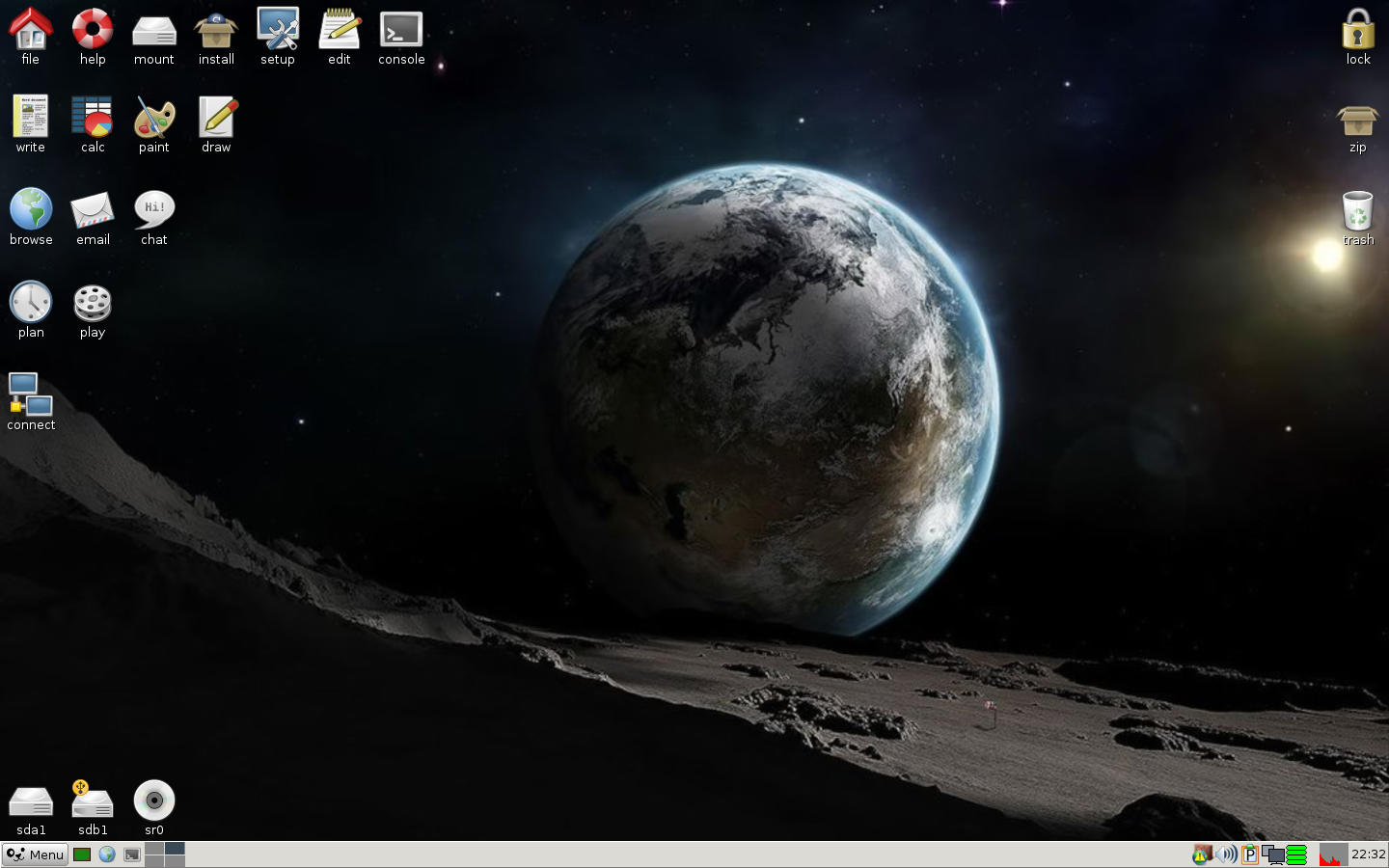
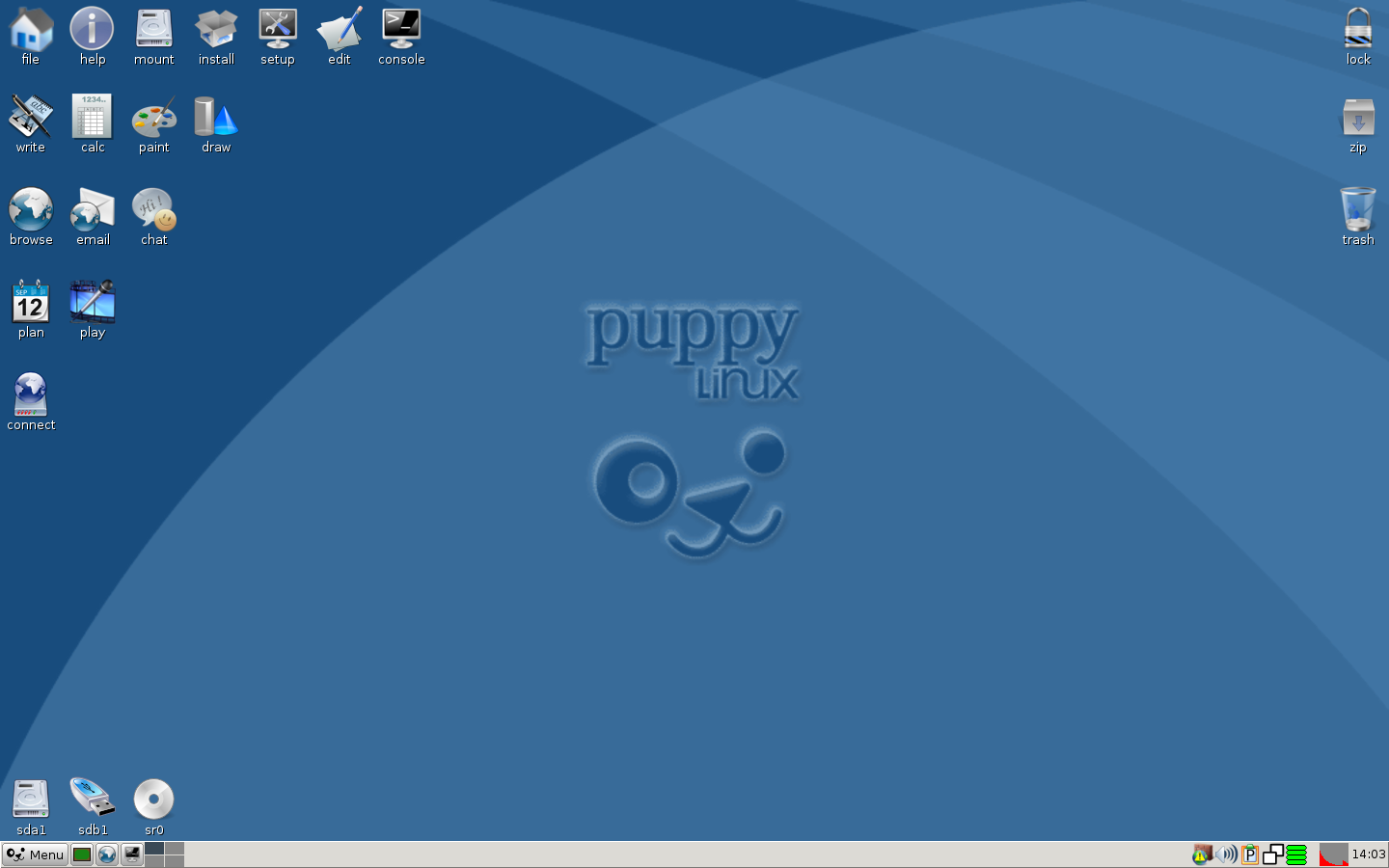

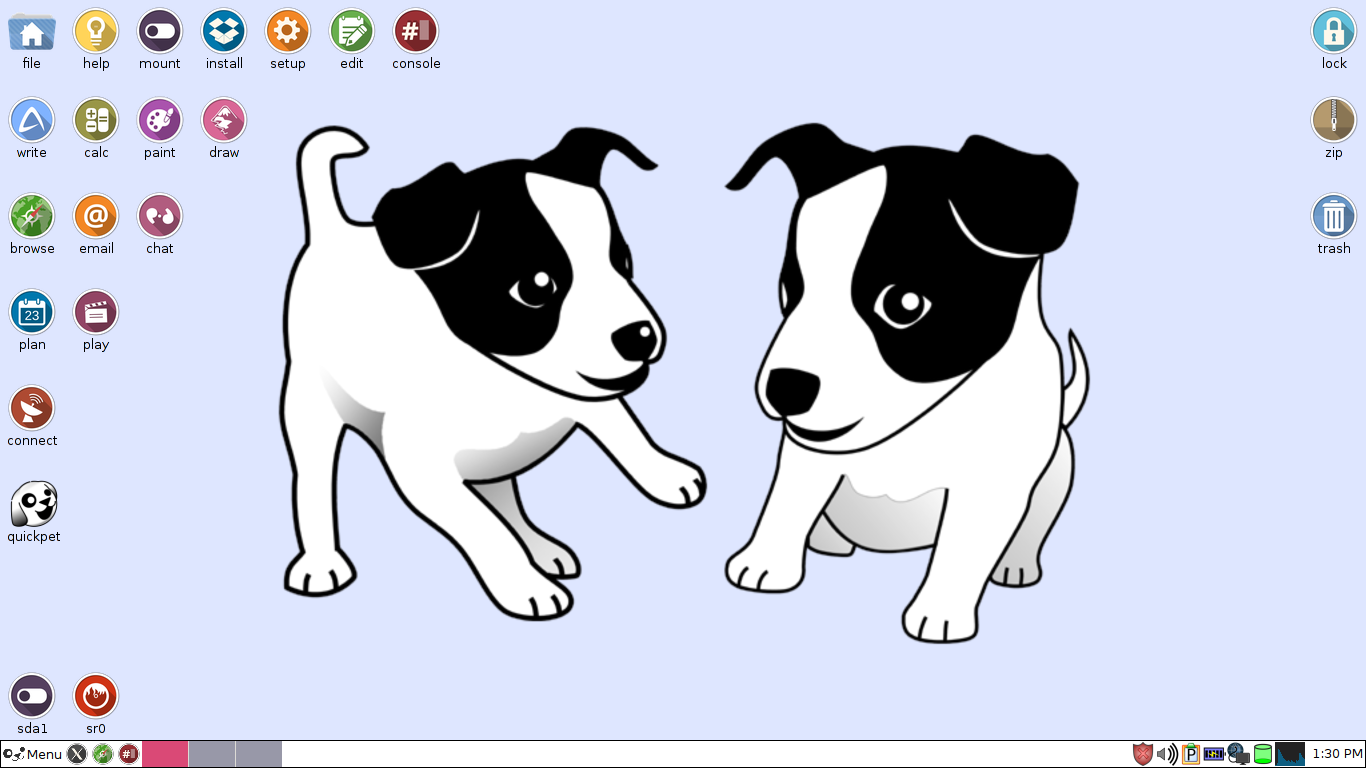
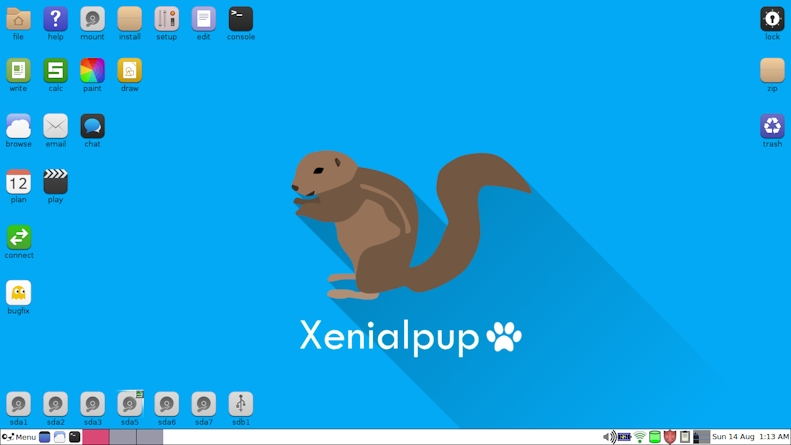 Puppy 0.1 is the initial release of Puppy Linux. It has no UnionFS, extremely minimal persistence support, and has no package manager or ability to install applications.
Puppy 1.0 series runs comfortably on very dated hardware, such as a Pentium computer with at least 32 MB RAM. For newer systems, the USB key drive version might be better (although if USB device booting is not directly supported in the
Puppy 0.1 is the initial release of Puppy Linux. It has no UnionFS, extremely minimal persistence support, and has no package manager or ability to install applications.
Puppy 1.0 series runs comfortably on very dated hardware, such as a Pentium computer with at least 32 MB RAM. For newer systems, the USB key drive version might be better (although if USB device booting is not directly supported in the
 The default
The default
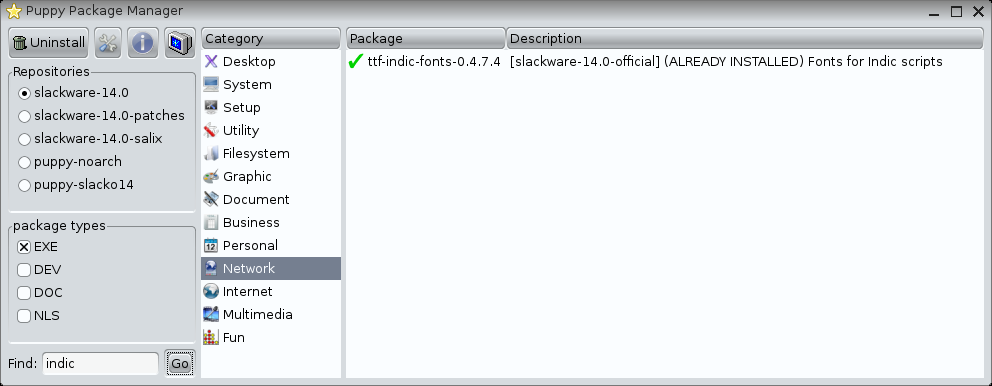 Puppy Linux's package manager, ''Puppy Package Manager'', installs packages in PET (Puppy Enhanced Tarball) format by default but it also accepts packages from other distros (such as .deb, .rpm, .txz, and .tgz packages) or by using third-party tools to convert packages from other distros to PET packages. ''Puppy Package Manager'' can also trim the software bloat of a package to reduce the disk space used.
Puppy Linux's package manager, ''Puppy Package Manager'', installs packages in PET (Puppy Enhanced Tarball) format by default but it also accepts packages from other distros (such as .deb, .rpm, .txz, and .tgz packages) or by using third-party tools to convert packages from other distros to PET packages. ''Puppy Package Manager'' can also trim the software bloat of a package to reduce the disk space used.
Community website
* {{Linux distributions Live USB Light-weight Linux distributions Operating system distributions bootable from read-only media Linux distributions without systemd Linux distributions IA-32 Linux distributions Independent Linux distributions
light-weight Linux distribution
A light-weight Linux distribution is a Linux distribution that uses lower memory and processor-speed requirements than a more "feature-rich" Linux distribution. The lower demands on hardware ideally result in a Responsiveness, more responsive mac ...
s that focus on ease of use and minimal memory footprint
Memory footprint refers to the amount of main memory that a program uses or references while running.
The word footprint generally refers to the extent of physical dimensions that an object occupies, giving a sense of its size. In computing, t ...
. The entire system can be run from random-access memory
Random-access memory (RAM; ) is a form of Computer memory, electronic computer memory that can be read and changed in any order, typically used to store working Data (computing), data and machine code. A random-access memory device allows ...
(RAM) with current versions generally taking up about 600 MB (64-bit), 300 MB (32-bit), allowing the boot medium to be removed after the operating system
An operating system (OS) is system software that manages computer hardware and software resources, and provides common daemon (computing), services for computer programs.
Time-sharing operating systems scheduler (computing), schedule tasks for ...
has started. Applications such as AbiWord, Gnumeric
Gnumeric is a spreadsheet program that is part of the GNOME Free Software Desktop Project. Gnumeric version 1.0 was released on 31 December 2001. Gnumeric is distributed as free software under the GNU General Public License; it is intended to ...
and MPlayer
MPlayer is a free and open-source media player software application. It is available for Linux, OS X and Microsoft Windows. Versions for OS/2, Syllable Desktop, Syllable, AmigaOS, MorphOS and AROS Research Operating System are also available. A ...
are included, along with a choice of lightweight web browsers and a utility for downloading other packages. The distribution was originally developed by Barry Kauler and other members of the community, until Kauler retired in 2013. The tool Woof can build a Puppy Linux distribution from the binary packages of other Linux distributions.
History
Barry Kauler started Puppy Linux in response to a trend of other distributions becoming stricter on system requirements over time. His own distribution, with an emphasis on speed and efficiency and being lightweight, started from "Boot disk HOWTO" and gradually included components file-by-file until Puppy Linux was completed. Puppy Linux was initially based on Vector Linux but then became a fully independent distribution.Release versions








 Puppy 0.1 is the initial release of Puppy Linux. It has no UnionFS, extremely minimal persistence support, and has no package manager or ability to install applications.
Puppy 1.0 series runs comfortably on very dated hardware, such as a Pentium computer with at least 32 MB RAM. For newer systems, the USB key drive version might be better (although if USB device booting is not directly supported in the
Puppy 0.1 is the initial release of Puppy Linux. It has no UnionFS, extremely minimal persistence support, and has no package manager or ability to install applications.
Puppy 1.0 series runs comfortably on very dated hardware, such as a Pentium computer with at least 32 MB RAM. For newer systems, the USB key drive version might be better (although if USB device booting is not directly supported in the BIOS
In computing, BIOS (, ; Basic Input/Output System, also known as the System BIOS, ROM BIOS, BIOS ROM or PC BIOS) is a type of firmware used to provide runtime services for operating systems and programs and to perform hardware initialization d ...
, the Puppy floppy boot disk can be used to kick-start it). It is possible to run Puppy Linux with Windows 9x/ Me. It is also possible if the BIOS does not support booting from USB drive, to boot from the CD and keep user state on a USB key drive; this is saved on shutdown and read from the USB device on bootup.
Puppy 2.0 uses the Mozilla-based SeaMonkey as its Internet suite
An Internet suite is an Internet-related software suite. Internet suites usually include a web browser, e-mail client (often with a news client and address book), download manager, HTML editor, and an IRC client.
The diversity of Internet suite o ...
(primarily a web browser
A web browser, often shortened to browser, is an application for accessing websites. When a user requests a web page from a particular website, the browser retrieves its files from a web server and then displays the page on the user's scr ...
and e-mail client).
Puppy 3.0 features Slackware 12 compatibility. This is accomplished by the inclusion of almost all the dependencies needed for the installation of Slackware packages. However, Puppy Linux is not a Slackware-based distribution.
Puppy 4.0 is built from scratch using the T2 SDE and no longer features native Slackware 12 compatibility in order to reduce the size and include newer package versions than those found in 3. To compensate for this, an optional "compatibility collection" of packages was created that restores some of the lost compatibility.
Puppy 4.2.0–4.3.0 feature changes to the user interface and backend, upgraded packages, language and character support, new in-house software and optimizations, while still keeping the ISO image size under 100 MB.
Puppy 5.0.0–5.7.0 are based on a project called Woof, which is designed to assemble a Puppy Linux distribution from the packages of other Linux distributions. Woof includes some binaries and software derived from Ubuntu
Ubuntu ( ) is a Linux distribution based on Debian and composed primarily of free and open-source software. Developed by the British company Canonical (company), Canonical and a community of contributors under a Meritocracy, meritocratic gover ...
, Debian
Debian () is a free and open-source software, free and open source Linux distribution, developed by the Debian Project, which was established by Ian Murdock in August 1993. Debian is one of the oldest operating systems based on the Linux kerne ...
, Slackware
Slackware is a Linux distribution created by Patrick Volkerding in 1993. Originally based on Softlanding Linux System (SLS), Slackware has been the basis for many other Linux distributions, most notably the first versions of SUSE Linux distr ...
, T2 SDE, or Arch
An arch is a curved vertical structure spanning an open space underneath it. Arches may support the load above them, or they may perform a purely decorative role. As a decorative element, the arch dates back to the 4th millennium BC, but stru ...
repositories. Puppy 5 came with a stripped-down version of the Midori browser to be used for reading help files and a choice of web browsers to be installed, including Chromium
Chromium is a chemical element; it has Symbol (chemistry), symbol Cr and atomic number 24. It is the first element in Group 6 element, group 6. It is a steely-grey, Luster (mineralogy), lustrous, hard, and brittle transition metal.
Chromium ...
, Firefox
Mozilla Firefox, or simply Firefox, is a free and open-source web browser developed by the Mozilla Foundation and its subsidiary, the Mozilla Corporation. It uses the Gecko rendering engine to display web pages, which implements curr ...
, SeaMonkey Internet Suite, Iron
Iron is a chemical element; it has symbol Fe () and atomic number 26. It is a metal that belongs to the first transition series and group 8 of the periodic table. It is, by mass, the most common element on Earth, forming much of Earth's o ...
and Opera
Opera is a form of History of theatre#European theatre, Western theatre in which music is a fundamental component and dramatic roles are taken by Singing, singers. Such a "work" (the literal translation of the Italian word "opera") is typically ...
.
Puppy 6.0.5 is built from Ubuntu 14.04 "Trusty Tahr" packages, has binary compatibility with Ubuntu 14.04 and access to the Ubuntu package repositories. Tahrpup is built from the woof-CE build system, forked from Barry Kauler's Woof late last year after he announced his retirement from Puppy development. It is built from the latest testing branch, incorporates all the latest woof-CE features and is released in PAE and noPAE ISOs, with the option to switch kernels.
Puppy 6.3.2 is built with Slackware packages instead of Ubuntu 14.04 "Trusty Tahr" packages but is very similar to its predecessor.
Puppy 7.5 is built from Ubuntu 16.04 "Xenial Xerus" packages, which has binary compatibility with Ubuntu 16.04 and access to the Ubuntu package repositories. XenialPup is built from the woof-CE build system, forked from Barry Kauler's Woof. It is built from the latest testing branch, incorporates all the latest woof-CE features and is released in PAE and noPAE ISOs, with the option to switch kernels. It has a new UI, a new kernel update for greater hardware compatibility, redesigned Puppy Package Manager, some bugfixes and base packages inclusion into the woof structure.
Puppy 8.0 is built from Ubuntu "Bionic Beaver" 18.04.2 packages, has binary compatibility with Ubuntu 18.04.2 and access to the Ubuntu package repositories. BionicPup is built from the woof-CE build system, forked from Barry Kauler's Woof. It is built from the latest testing branch and incorporates all the latest woof-CE features.
Puppy 8.2.1 is built from Raspberry Pi OS
Raspberry Pi OS is a Unix-like operating system developed for the Raspberry Pi line of single-board computers. Based on Debian, a Linux distribution, it is maintained by Raspberry Pi Holdings and optimized for Raspberry Pi hardware, with low memo ...
packages, has full support for the Raspberry Pi 0 to the Raspberry Pi 4, and is relatively similar to its predecessor. Raspberry Pi OS is based on Debian, meaning that Puppy Linux still has Debian/Ubuntu support. This version of Puppy Linux is not compatible with personal computers, like desktops or laptops.
Puppy 9.5 is built from Ubuntu "Focal Fossa" 20.04 (64-bit) packages, has binary compatibility with Ubuntu 20.04 and access to the Ubuntu repositories. FossaPup64 comes with JWM as the default window manager. Also, at this release, Puppy Linux's Ubuntu-based release has dropped support for 32-bit (x86) computers, due to Ubuntu dropping 32-bit support at this release before reverting its decision and supporting only select 32-bit libraries. However, its Debian-based and mixed releases (i.e., BookwormPup32 and NoblePup32, respectively) continue to support 32-bit systems.
Features
Puppy Linux is a complete operating system bundled with a collection of applications suited to general use tasks. It can be used as a rescue disk, a demonstration system that leaves the previous installation unaltered, as an accommodation for a system with a blank or missing hard drive, or for using modern software on legacy computers. Puppy's compact size allows it to boot from any media that the computer can support. It can function as a live USB for flash devices or otherUSB
Universal Serial Bus (USB) is an industry standard, developed by USB Implementers Forum (USB-IF), for digital data transmission and power delivery between many types of electronics. It specifies the architecture, in particular the physical ...
mediums, a CD, an internal hard disk drive
A hard disk drive (HDD), hard disk, hard drive, or fixed disk is an electro-mechanical data storage device that stores and retrieves digital data using magnetic storage with one or more rigid rapidly rotating hard disk drive platter, pla ...
, an SD card
Secure Digital (SD) is a proprietary, non-volatile, flash memory card format developed by the SD Association (SDA). Owing to their compact size, SD cards have been widely adopted in a variety of portable consumer electronics, including dig ...
, a Zip drive
The Zip drive is a removable floppy disk storage system that was announced by Iomega in 1994 and began shipping in March 1995. Considered medium-to-high-capacity at the time of its release, Zip disks were originally launched with capacities ...
or LS-120/240 SuperDisk, through PXE PXE may refer to:
Science and technology
* Pentium Extreme Edition, a variant of the Pentium D microprocessor
* Preboot Execution Environment, booting computers via a network
* Pseudoxanthoma elasticum, a genetic disease
Other uses
* Proof and Exp ...
, and through a floppy boot disk
A boot disk is a removable digital data storage medium from which a computer can load and run ( boot) an operating system or utility program. The computer must have a built-in program which will load and execute a program from a boot disk meeting ...
that chainloads the data from other storage media. It has also been ported to ARM and can run on a single-board computer such as the Raspberry Pi
Raspberry Pi ( ) is a series of small single-board computers (SBCs) developed in the United Kingdom by the Raspberry Pi Foundation in collaboration with Broadcom Inc., Broadcom. To commercialize the product and support its growing demand, the ...
.
Puppy Linux features built-in tools which can be used to create bootable USB drives, create new Puppy CDs, or remaster a new live CD with different packages. It also uses a sophisticated write-caching system with the purpose of extending the life of live USB flash drives.
Puppy Linux includes the ability to use a normal persistent updating environment on a write-once multisession CD/DVD that does not require a rewritable disc; this is a unique feature that sets it apart from other Linux distributions. While other distributions offer live CD
A live CD (also live DVD, live disc, or live operating system) is a complete booting, bootable computer installation including operating system which runs directly from a CD-ROM or similar storage device into a computer's memory, rather than lo ...
versions of their operating systems, none offer a similar feature.
Puppy's bootloader does not mount hard drives or connect to the network automatically. This ensures that a bug or even unknowingly incompatible software won't corrupt the contents of such devices.
Puppy Linux offers a session save on shutdown. Since Puppy Linux fundamentally runs in RAM, any files and configurations made or changed in a session would disappear otherwise. This feature enables the user to either save the contents to a writable storage medium, or write the file system to the same CD containing Puppy, if "multisession" was used to create the booted CD and if the disc drive supports burning. This applies to CD-Rs, CD-RWs, and DVDs.
It is also possible to save all files to an external hard drive, USB stick, or even a floppy disk instead of the root file system. Puppy can also be installed to a hard disk.
User interface
 The default
The default window manager
A window manager is system software that controls the placement and appearance of window (computing), windows within a windowing system in a graphical user interface. Most window managers are designed to help provide a desktop environment. They ...
in most Puppy releases is JWM.
Packages of the IceWM
IceWM is a stacking window manager for the X Window System, originally written by Marko Maček. It was written from scratch in C++ and is released under the terms of the GNU Lesser General Public License.
It is customizable, relatively light ...
desktop, Fluxbox
Fluxbox is a stacking window manager for the X Window System, which started as a fork of Blackbox 0.61.1 in 2001, with the same aim to be lightweight. Its user interface has only a taskbar, a pop-up menu accessible by right-clicking on the d ...
and Enlightenment are also available via Puppy's PetGet package (application) management system (see below). Some derivative distributions, called ''puplets'', come with default window managers other than JWM.
When the operating system boots, everything in the Puppy package uncompresses into a RAM area, the " ramdisk". The PC needs to have at least 128 MB of RAM (with no more than 8 MB shared video) for all of Puppy to load into the ramdisk. However, it is possible for it to run on a PC with only about 48 MB of RAM because part of the system can be kept on the hard drive, or less effectively, left on the CD.
Puppy is fairly full-featured for a system that runs entirely in a ramdisk, when booted as Live system or from a "frugal" installation. However, Puppy also supports the "full" installation mode, which enables Puppy to run from a hard drive partition, without a ramdisk. Applications were chosen that met various constraints, size in particular. Because one of the aims of the distribution is to be extremely easy to set up, there are many wizards that guide the user through a wide variety of common tasks.
Package and distribution management
 Puppy Linux's package manager, ''Puppy Package Manager'', installs packages in PET (Puppy Enhanced Tarball) format by default but it also accepts packages from other distros (such as .deb, .rpm, .txz, and .tgz packages) or by using third-party tools to convert packages from other distros to PET packages. ''Puppy Package Manager'' can also trim the software bloat of a package to reduce the disk space used.
Puppy Linux's package manager, ''Puppy Package Manager'', installs packages in PET (Puppy Enhanced Tarball) format by default but it also accepts packages from other distros (such as .deb, .rpm, .txz, and .tgz packages) or by using third-party tools to convert packages from other distros to PET packages. ''Puppy Package Manager'' can also trim the software bloat of a package to reduce the disk space used.
Building the distribution
On earlier releases of Puppy Linux, Puppy Unleashed was used to create Puppy ISO images. It consists of more than 500 packages that are put together according to the user's needs. However, on later versions starting with Puppy Linux version 5.0, it was replaced by Woof. It is an advanced tool for creating Puppy installations. It requires an Internet connection and some knowledge of Linux to use. It is able to download the binary source packages from anotherLinux distribution
A Linux distribution, often abbreviated as distro, is an operating system that includes the Linux kernel for its kernel functionality. Although the name does not imply product distribution per se, a distro—if distributed on its own—is oft ...
and process them into Puppy Linux packages by just defining the name of that Linux distro. It is equipped with a simpler version control named Bones on earlier releases but on later versions of woof, Fossil version control is used.
Puppy also comes with a remastering tool that takes a "snapshot" of the current system and lets the user create a live CD from it, and an additional remastering tool that is able to remove installed components.
Puppy Linux uses the T2 SDE build scripts to build the base binary packages.
Official variants
Because of the relative ease with which the Woof tool and the remaster tool can be used to build variants of Puppy Linux, there are many variants available. Variants of Puppy Linux are known as ''puplets''. After Barry Kauler reduced his involvement with the Puppy Project, he designed two new distributions within the same Puppy Linux family: Quirky and Wary. Quirky – An embedded, less-stable distro with all files contained in an initramfs built into the kernel. It has simple module loading management but fewer drivers are included. It is used for experimental purposes. Racy – A variant of puppy optimized for newer PCs. Wary – A Puppy variant targeted at users with old hardware. It uses an older Linux kernel, which has long-term support and the newest applications. Easy – A puppy variant in which the init script is completely rewritten and which uses originally developed application containers aside the conventional package management.Reception
DistroWatch reviewer Rober Storey concluded about Puppy 5.2.5 in April 2011: "A lot of people like Puppy — it's in the top 10 of the DistroWatch page-hit ranking. I enjoy Puppy too, and it's what I run exclusively on my netbook. Maybe the only thing wrong with Puppy is that users' expectations tend to exceed the developer's intentions." In a detailed review of Puppy Linux in May 2011 Howard Fosdick of OS News addressed the fact that Puppy Linux the user runs as the root UID, "In theory this could be a problem — but in practice it presents no downside. I've never heard of a single Puppy user suffering a problem due to this." Fosdick concluded "I like Puppy because it's the lightest Linux distro I've found that is still suitable for end users. Install it on an old P-III or P-IV computer and your family or friends will use it just as effectively for common tasks as any expensive new machine." In December 2011 Jesse Smith, writing in DistroWatch, reviewed Puppy 5.3.0 ''Slacko Puppy''. He praised its simplicity, flexibility and clear explanations, while noting the limitations of running as root. He concluded "I would also like to see an option added during the boot process which would give the user the choice of running in unprivileged mode as opposed to running as root. Always being the administrator has its advantages for convenience, but it means that the user is always one careless click away from deleting their files and one exploit away from a compromised operating system. As a live CD it's hard to beat Puppy Linux for both performance and functional software. It has minimal hardware requirements and is very flexible. It's a great distro as long as you don't push it too far out of its niche." In December 2011 Howard Fosdick reviewed the versions of Puppy Linux then available. He concluded, "Puppy's diversity and flexibility make it a great community-driven system for computer enthusiasts, hobbyists, and tinkerers. They also make for a somewhat disorderly world. You might have to read a bit to figure out which Puppy release or Puplet is for you. Puppy's online documentation is extensive but can be confusing. It's not always clear which docs pertain to which releases. Most users rely on the active, friendly forum for support." He also noted "Those of us who enjoy computers sometimes forget that many view them with disdain. What's wrong with it now? Why do I have to buy a new one every four years? Why on earth do they change the interface in every release? Can't it just work? Puppy is a great solution for these folks. It's up-to-date, free, and easy to use. And now, it supports free applications from the Ubuntu, Slackware, or Puppy repositories. Now that's user-friendly." An April 2020 review of Bionic 8.0 by Igor Ljubuncic in ''Dedoimedo'' concluded, "Puppy Linux delivered on its happy message, and even exceeded my expectations. Now, I've always been a fan, and rarely had anything bad to say, so a positive result was kind of warranted. What really amazed me was not that this is a lean and fast little distro - it's the fact it manages to keep its relevance despite the obvious lethargy in the Linux desktop space. You may say, well, why bother - but if you have older hardware or travel a lot, Puppy gives you your own, complete work session that will boot and run pretty much anywhere, with tons of goodies and excellent configuration tools."See also
* Lightweight Linux distribution * List of Linux distributions that run from RAMReferences
External links
*Community website
* {{Linux distributions Live USB Light-weight Linux distributions Operating system distributions bootable from read-only media Linux distributions without systemd Linux distributions IA-32 Linux distributions Independent Linux distributions